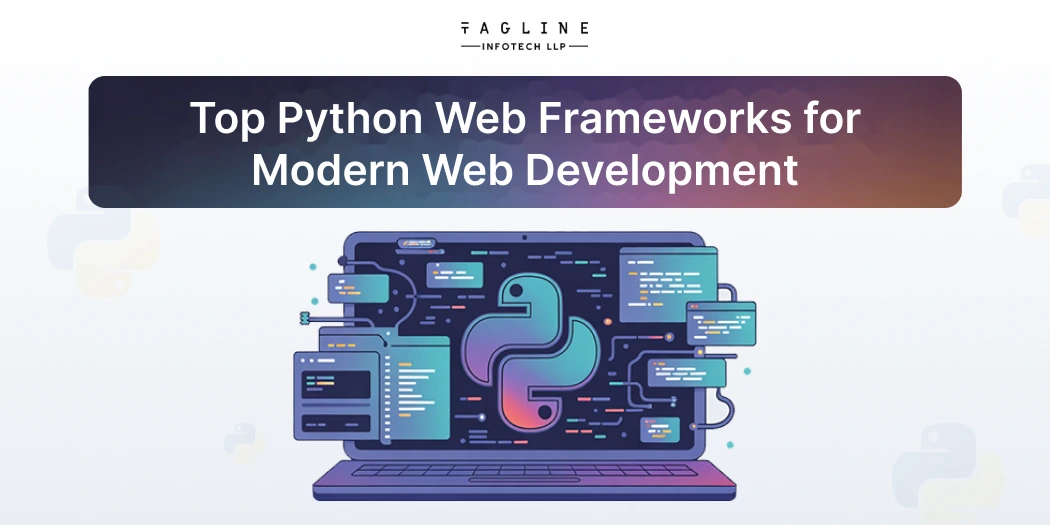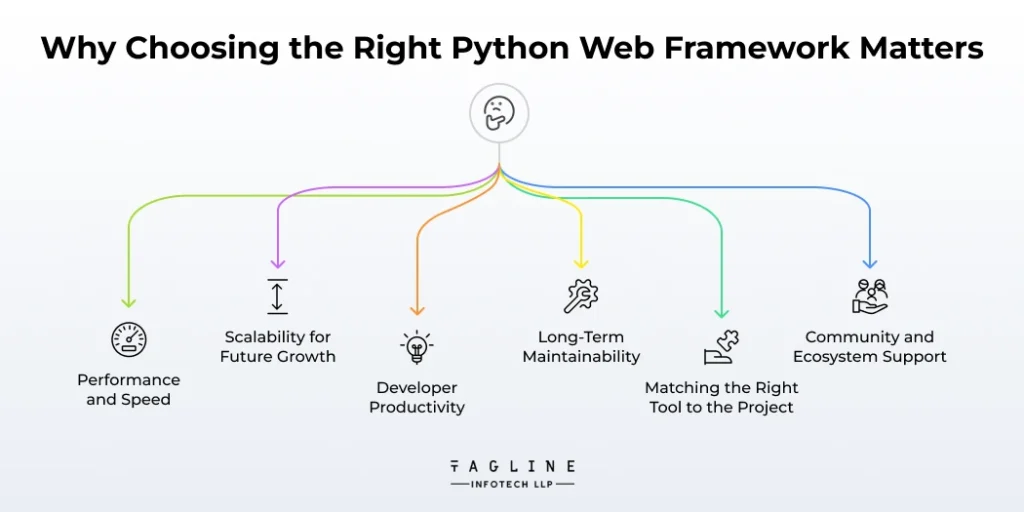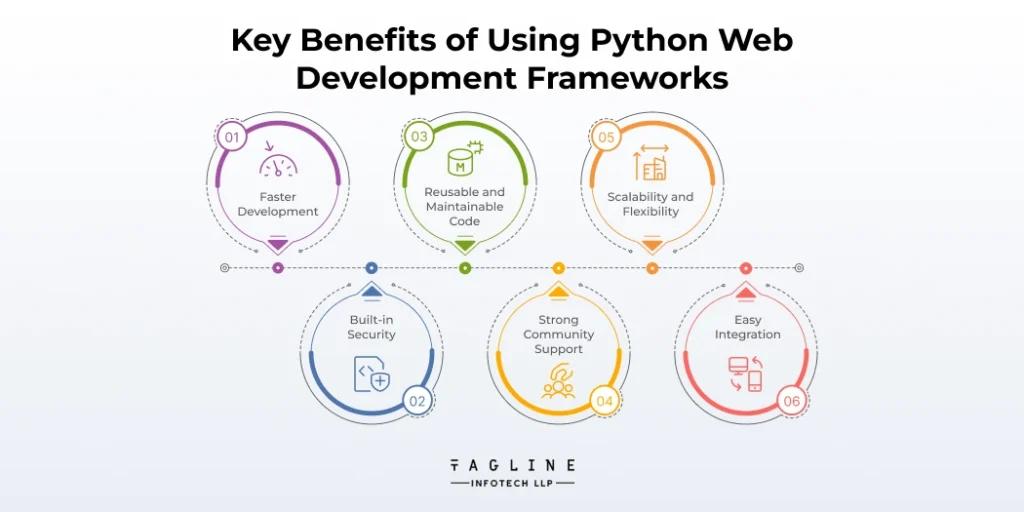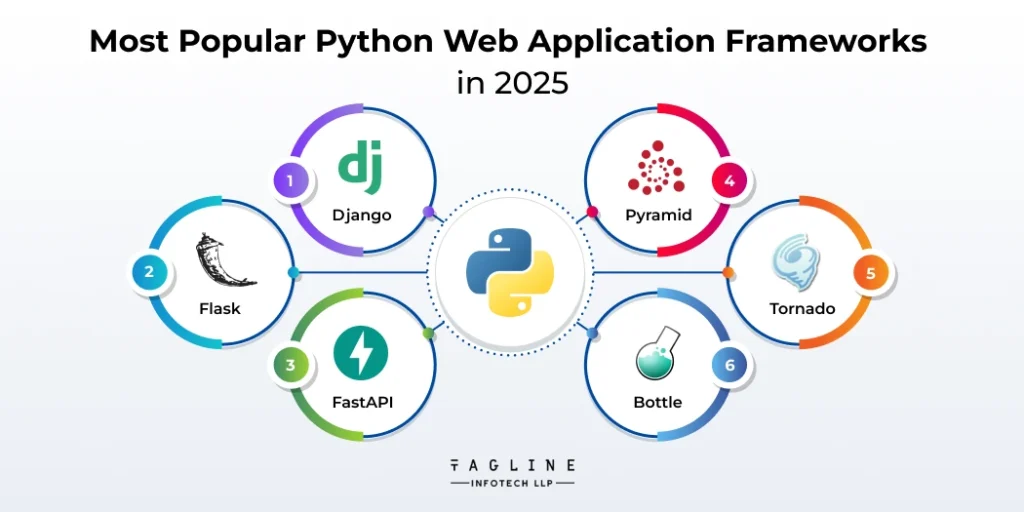5 Project Ideas for Web Developers
September 19, 2025
Home >> Python >> Top Python Web Frameworks for Modern Web Development

Python has become one of the most popular languages in modern web development, and for good reason. Its simplicity, readability, and large ecosystem of frameworks make it a favorite among developers, from startups to enterprise-level companies. Whether you’re building a small MVP or a full-fledged scalable platform, a skilled Python Development Company can leverage Python’s web frameworks to speed up your development and simplify complex tasks.
In this blog, we’ll dive deep into the top Python website frameworks in 2025 and help you decide which one fits your project best.

When building a web application, the framework you choose can make or break your project. In the world of Python web development, selecting the right framework isn’t just about coding preferences — it directly impacts the success, performance, and scalability of your application.
Here’s why choosing the right Python web framework truly matters:
The framework acts as the foundation of your web application. Some Python frameworks are optimized for high performance and are ideal for real-time applications or high-traffic platforms. For example, FastAPI is known for its speed and asynchronous capabilities, making it perfect for APIs and data-heavy apps. On the other hand, full-stack frameworks like Django offer more built-in features but may have a higher overhead in specific use cases.
2. Scalability for Future Growth
If you expect your application to grow over time, in terms of users, data, or features, scalability is key. A framework like Pyramid or Django can handle complex architectures and large-scale applications with ease. Micro-frameworks such as Flask or Bottle are better suited for lightweight projects, but can require more manual work when scaling up.
3. Developer Productivity
The framework you choose affects how quickly your development team can build and iterate. Full-stack frameworks offer built-in components like admin panels, ORM (Object-Relational Mapping), and authentication systems, which speed up development. Django, for example, promotes rapid development with a “batteries-included” philosophy. In contrast, minimalist frameworks give more flexibility but often require developers to build these tools from scratch or integrate external packages.
4. Long-Term Maintainability
A good framework helps ensure your project remains manageable over time. Clean architecture, solid documentation, and a strong developer community all contribute to easier maintenance. Choosing a mature and well-supported framework reduces the risk of technical debt and ensures that you can keep your app updated with minimal hassle.
5. Matching the Right Tool to the Project
Each project has unique needs — whether it’s a content-driven platform, a RESTful API, or a real-time messaging service. Choosing the wrong framework could lead to inefficiencies, unnecessary complexity, or even a full rebuild down the road. For example:
6. Community and Ecosystem Support
Frameworks with strong community support tend to evolve faster, receive frequent updates, and offer a wide array of plugins or extensions. This support network makes development smoother and helps resolve issues quickly. Django and Flask, for instance, have large, active communities that contribute to their continued success.
In summary, your choice of Python web framework has a lasting impact. It affects how fast you build, how well your app performs, how easily it scales, and how smoothly it can be maintained. Making the right decision from the start sets your project up for long-term success.

Python web development frameworks have become essential tools for developers aiming to build efficient, scalable, and secure web applications. Whether you’re launching a simple website or developing a complex enterprise-grade platform, Python frameworks offer a range of advantages that streamline the development process and boost overall productivity.
Here’s a closer look at the key benefits of using Python web development frameworks:
Frameworks like Django and Flask come with pre-built tools and modules, reducing the need to write code from scratch and speeding up project delivery.
They include security features to protect against common threats like SQL injection, CSRF, and XSS, helping developers build secure applications quickly.
Python frameworks promote clean, modular code that’s easy to reuse and maintain—ideal for long-term and large-scale projects.
Popular frameworks have active communities, offering plenty of documentation, tutorials, and third-party tools to support developers.
Whether you’re building a small app or a large platform, Python frameworks scale easily and can adapt to any project size.
They integrate well with databases, front-end tools, cloud services, and DevOps pipelines, making them suitable for modern development needs.

Let’s explore the top Python frameworks developers are using in 2025:
Django is a powerhouse. It follows the “batteries included” philosophy, meaning it comes with nearly everything you need out of the box:
Use Cases: CMS platforms, eCommerce websites, enterprise apps
Popular Sites: Instagram, Pinterest, Disqus
Flask is a micro-framework that gives you full control. It’s ideal for smaller projects or microservices architecture.
Use Cases: RESTful APIs, microservices, quick prototypes
Popular Sites: Netflix (parts of it), Reddit’s API
FastAPI is the new favorite among API developers in 2025.
Use Cases: Real-time APIs, ML model deployment, modern web apps
Popular Sites: Uber, Microsoft internal APIs
4. Pyramid – A Balance Between Simplicity and Power
Pyramid sits between Django and Flask in terms of complexity.
Use Cases: Mid-size business apps, dashboards
Popular Sites: Mozilla, SurveyMonkey
5. Tornado – For Real-Time Web Applications
Tornado is an asynchronous framework built for performance.
Use Cases: Chat applications, dashboards, notifications
Popular Sites: FriendFeed (originally developed by them)
6. Bottle – Minimalist Framework for Small Web Projects
Bottle is a single-file micro-framework best suited for small projects and learning purposes.
Use Cases: Prototypes, internal tools, small utilities
| Framework | Type | Best For | Async Support | Popularity |
|---|---|---|---|---|
| Django | Full-Stack | Scalable Apps | No (limited) | ⭐⭐⭐⭐⭐ |
| Flask | Micro | Microservices | Via Extensions | ⭐⭐⭐⭐ |
| FastAPI | Micro | High-performance APIs | Yes | ⭐⭐⭐⭐⭐ |
| Pyramid | Hybrid | Mid-size projects | Yes | ⭐⭐⭐ |
| Tornado | Async | Real-time apps | Yes | ⭐⭐⭐ |
| Bottle | Micro | Small utilities | No | ⭐⭐ |
Choosing the right framework depends on your goals, team, and application type. Consider these:
There’s no universal answer when it comes to selecting the best Python framework. Your choice should be based on your project needs, and in many cases, it’s wise to hire Python developer experts who can guide you toward the right solution
Whether you’re building a full-scale marketplace or a small internal tool, Python has a framework that’s just right for you.
FastAPI is best for APIs with fast performance and auto-docs.
Yes, Django scales well and suits complex, large applications.
Choose Django for full features, Flask for more flexibility.
Tornado and FastAPI support real-time features and async apps.

Digital Valley, 423, Apple Square, beside Lajamni Chowk, Mota Varachha, Surat, Gujarat 394101
D-401, titanium city center, 100 feet anand nagar road, Ahmedabad-380015
+91 9913 808 2851133 Sampley Ln Leander, Texas, 78641
52 Godalming Avenue, wallington, London - SM6 8NW